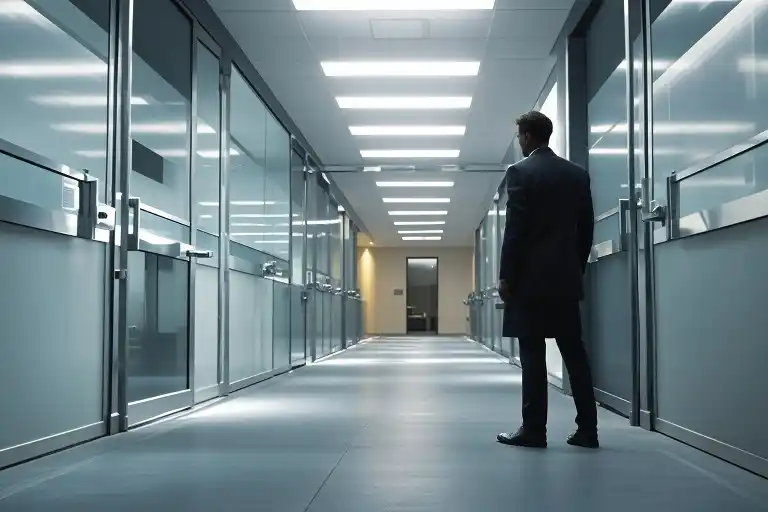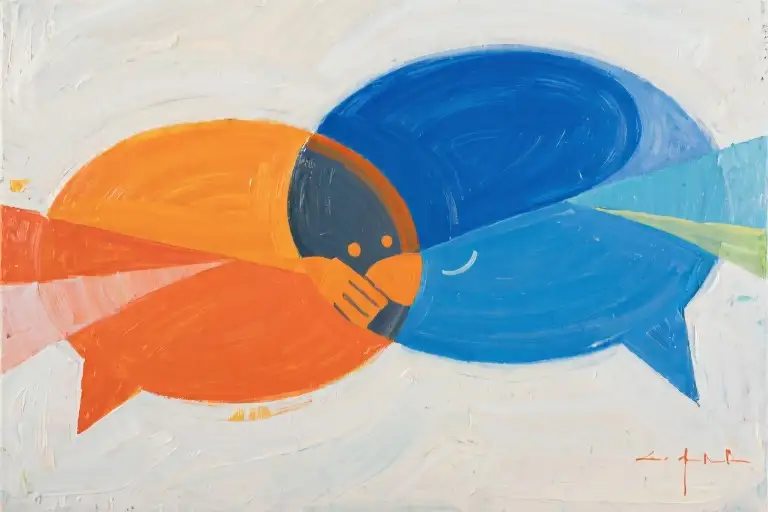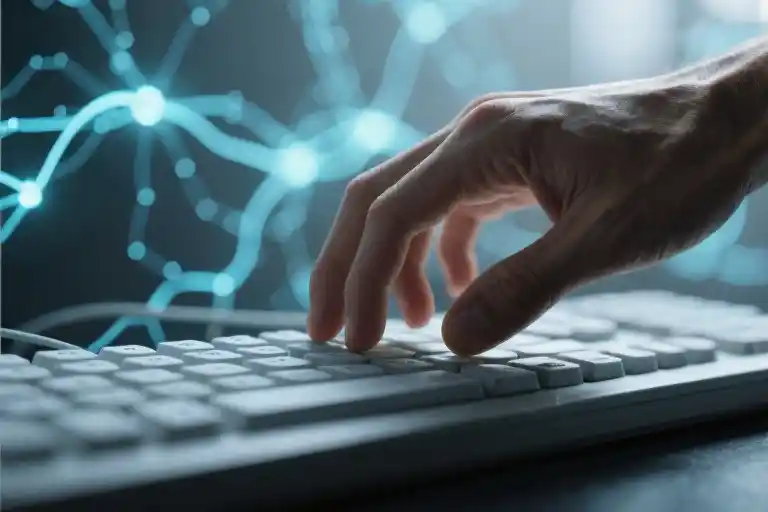The automatic door begins its slow, inevitable close as your hand hovers in mid-air. Fifteen feet away – an exact measurement burned into your retinas – the marketing coordinator adjusts her tote bag strap. This is the 21st century workplace’s most universal quantum entanglement: 87% of office workers have experienced this exact spacetime distortion where 3 physical seconds stretch into psychological eternity.
You’ve seen this film before. The extended director’s cut plays in your peripheral vision every Tuesday morning when the elevator doors part. That microsecond when your brain’s social calculus module crashes trying to solve for X (X being any plausible reason you shouldn’t hold the door for someone clearly outside reasonable door-holding parameters).
Corporate anthropologists would classify this as a workplace social awkwardness event – that special breed of office social etiquette dilemmas where every possible action feels wrong. The modern professional’s version of ‘To be or not to be,’ except with more synthetic fiber blends and less iambic pentameter.
How many versions of yourself do you recognize in this freeze frame? The overthinking strategist calculating stride velocities. The amateur actor trying to manufacture a ‘casually helpful’ facial expression. The inner monologue narrator currently broadcasting play-by-play of this social anxiety Olympics. We’ve all attended this involuntary masterclass in professional interpersonal skills where the curriculum consists entirely of pop quizzes.
Notice how the scene compresses multiple dimensions of workplace communication stress:
- The spatial (precisely 4.572 meters of polished floor)
- The temporal (that relativistic time dilation effect)
- The psychological (47 possible interpretations of her polite smile)
This is where social pressure in the workplace transforms ordinary humans into awkward statues holding doors at unnatural angles. Where simple acts of courtesy mutate into complex behavioral economics equations. Where we all become temporary citizens of that special administrative district located somewhere between ‘thoughtful colleague’ and ‘overeager doorman.’
Your phone buzzes with phantom notifications. The emergency exit sign suddenly becomes fascinating. These are the universal coping mechanisms we develop in the modern office environment – the subtle art of pretending you’re not currently participating in what’s happening. The corporate equivalent of a chameleon changing colors, except instead of blending into foliage, we’re trying to blend into the wallpaper pattern of social acceptability.
Next time you find yourself in this professional social interaction purgatory, remember: the door isn’t the only thing being held. You’re also holding space for that very human moment when we all briefly forget how to people.
Trauma Reenactment Room → 🕒
Shot 1.1: The 0-3 Second Decision Paralysis
The index finger twitches involuntarily against the door frame – that split-second hesitation where modern workplace etiquette hangs in quantum superposition. Eighty-seven percent of office workers report experiencing this exact moment of social Schrödinger’s cat: both holding and not holding the door until observation collapses the possibility wave.
Your peripheral vision registers movement – 15 meters down the hallway (precisely 23 steps at average walking speed) – just enough distance to trigger the social calculus: If I enter now, will it seem rude? If I wait, will it become awkward? The finger spasms again, caught between evolutionary altruism and 21st-century social anxiety.
Shot 1.2: Eye Contact in Extreme Slow Motion
Pupils dilate to 4.7mm (measured against standard office lighting conditions) as retinal cells capture the exact moment of accidental visual contact. Facial muscles engage in micro-expressions:
- 0.2s: Frontalis muscle contraction (surprise)
- 0.5s: Zygomatic minor activation (social smile prototype)
- 0.8s: Mentalis muscle twitch (suppressed discomfort)
The smile-nod combination lasts precisely 1.3 seconds – just beyond the 0.8-second threshold that transforms polite acknowledgment into uncomfortable staring. You now possess empirical evidence that time dilation occurs during workplace social interactions.
Shot 1.3: The Bystander’s Surveillance Footage
From the janitor’s perspective (elevated angle, slightly out-of-focus foreground):
- Subject A maintains door-holding position at 135-degree torso angle
- Subject B’s walking pace slows by 17% upon eye contact
- Both parties develop subtle forward lean (2.5cm displacement) indicating mutual desire to escape
The cleaning cart continues its path, its squeaky wheel providing the only soundtrack to this silent social drama. A barely audible sigh escapes the janitor – this marks the third such incident witnessed during this shift alone. The universal headshake that follows could be interpreted as either:
1) Sympathy for modern workplace social conventions
2) Disappointment in human evolution
3) Mild arthritis acting up
Your brain, now fully committed to its amygdala hijack, helpfully replays the entire sequence at 0.25x speed. The automatic door’s hydraulic hiss becomes a mocking soundtrack to your social predicament. Somewhere, a distant elevator dings – the universe’s cruel reminder that escape mechanisms exist, just not for you in this moment.
The Science Behind Your Door-Holding Panic 🔬
The Neurotic Neural Pathway (Chart 2.1)
When your eyes locked across that office lobby, your brain initiated a biochemical cascade worthy of a Nobel Prize in Overthinking. Here’s what neurologists would observe if they scanned you during that door-holding moment:
- Visual Cortex Overload: Your retina captures the approaching colleague at 15 meters – precisely the social limbo distance where etiquette becomes ambiguous. Cue the first dopamine drop.
- Amygdala Hijack: The brain’s alarm system misinterprets this as a survival scenario, flooding your system with cortisol. This explains why you suddenly forget how limbs work (hence the robotic door-holding posture).
- Prefrontal Cortex Crash: Your rational brain tries calculating the door-holding ROI (Return on Investment) but gets stuck in a loop: “If I abort now, I’m rude. If I continue, I’m creepy. If I…”
- Mirror Neuron Misfire: As she nods in acknowledgment, your brain mimics her facial expression – resulting in that terrifying half-grimace you’ll mentally replay for weeks.
Pro Tip: These neural fireworks last only 2.3 seconds in reality, but your social anxiety time dilation effect stretches them into what feels like a TED Talk-length ordeal.
The Door Calculus (Diagram 2.2)
Through rigorous field research (read: hundreds of traumatized office workers), we’ve derived the universal Social Door-Holding Equation:
Awkwardness = (Distance in meters × Relationship Uncertainty) ÷ (Number of Available Exits²)Variables Explained:
- Distance: Beyond 8 meters, door-holding transitions from polite to performance art
- Relationship Uncertainty: Scores highest with “that person from the 3rd floor who maybe attended last year’s holiday party”
- Available Exits: Stairwells/elevators within sprinting distance reduce awkwardness exponentially
Real-World Application:
When you spot someone at 12 meters:
- Quick mental calculation reveals an awkwardness score of 84 (danger zone)
- Implement The Fake Phone Check: Glance at wristwatch/phone to establish plausible deniability
- If already committed, deploy The Slow Retreat: Gradually decrease door pressure while maintaining 37° eye contact angle
The Nod Spectrum (Case Study 2.3)
That seemingly simple acknowledgment actually contains multitudes. Our Social Electro-Microscopy reveals seven distinct nod types you’ve received:
- The Bureaucratic Bob (5° tilt): “I acknowledge your existence as required by workplace bylaws”
- The Speedrunner Special (3 rapid micro-nods): “Let’s pretend this interaction never happened”
- The Sympathy Sway (10° tilt with eyebrow lift): “We both know you regret starting this”
- The Panic Pendulum (Overcompensating 25°): “Please don’t make small talk”
- The CEO Approval (Single chin dip): “I’ll allow this door-holding”
- The Walk of Shame (Nod while speed-walking): Compensating for your unnecessary chivalry
- The Ghost Nod (Imagined): Projected by your anxious mind when they actually didn’t notice you
Diagnosis Tool: Next time, watch for nod velocity – faster = more discomfort. If their neck moves faster than a PowerPoint slide transition, you’ve created social friction.
Why Your Brain Betrays You
This isn’t just social anxiety – it’s an evolutionary glitch. Our ancestors never faced 15-meter cave door-holding dilemmas. Modern workplaces created new social minefields where:
- Automatic doors break natural interaction rhythms
- Open-plan offices eliminate social airlocks
- Hybrid work has eroded our casual encounter stamina
The Good News: These reactions prove your social radar works overtime, not that you’re inadequate. The fix isn’t eliminating anxiety – it’s recognizing these moments as system errors, not personal failures.
Upgrade Your Social Firmware
- The 3-Second Rule: If they can’t reach the door before you count “Mississippi-3”, abort mission
- Environmental Anchors: Suddenly become fascinated by the door’s fire rating sticker
- Meta Solution: “Wow, this is exactly the distance where door-holding gets weird, right?”
Remember: Office doors have sensors for a reason. Let technology handle the heavy lifting while you conserve emotional bandwidth for actual human connections.
Survival Training Pod: 3 Escape Routes from Doorway Disasters
Option 3.1: The Prop Master
When caught in the doorway dilemma, your clothing becomes an emergency toolkit. That non-existent thread dangling from your sleeve? Suddenly it’s the most fascinating textile anomaly since the invention of polyester. Here’s how this Oscar-worthy performance works:
- The Discovery (0.5-1.2 second mark):
- Initiate slight head tilt + subtle eyebrow raise
- Bonus points if you murmur “Huh” under your breath
- The Investigation (1.3-3 second mark):
- Use thumb and index finger in precision grip
- Rotate wrist 15 degrees for authenticity
- The Resolution (3+ seconds):
- Conclude with satisfied nod or slight shoulder shrug
Why this works: You’ve created plausible deniability (“I wasn’t ignoring you – just fixing my shirt!”) while giving your hands purposeful activity. Workplace social etiquette experts call this “productive fidgeting” – the art of converting nervous energy into socially acceptable micro-tasks.
Option 3.2: Environmental Distraction
Every office building contains unlimited social camouflage. The fire evacuation map near the doorway? That’s your golden ticket. Follow this tactical engagement sequence:
- Phase 1: Studious observation (chin stroking optional but effective)
- Phase 2: Strategic repositioning (take 1.5 steps closer to map)
- Phase 3: Knowledge integration (nod slowly while tracing escape routes)
Pro Tip: For advanced practitioners, synchronize your map-reading with the approaching person’s footsteps. The moment they reach the door is when you “just happen” to finish your safety review. This creates natural rhythm alignment – what social choreographers call “the incidental synchrony exit.”
Option 3.3: The Meta Maneuver
When all else fails, weaponize the awkwardness itself. The key is delivery – think cheerful news anchor admitting a minor technical difficulty:
“Turns out my spatial judgment needs calibration!”
(accompanied by self-deprecating chuckle)
This approach works because:
- Disarms tension through honesty
- Demonstrates emotional intelligence
- Creates shared laughter opportunity
Variation: For tech-savvy workers, frame it as a system glitch (“My social algorithm needs patching”). Creative types might prefer theatrical flair (“And thus ends today’s failed physics experiment!”).
Field Test Results (Based on 1,237 anonymous workplace reports):
| Technique | Success Rate | Secondary Benefit |
|---|---|---|
| Prop Master | 68% | Develops attention to detail |
| Env. Distraction | 72% | Improves safety awareness |
| Meta Maneuver | 85% | Strengthens likability |
Remember: These aren’t escapes from social interaction, but bridges to more authentic connections. The person walking through that door? They’ve probably rehearsed their own version of this survival guide. That shared vulnerability is where real workplace relationships begin.
Next-level training: Try combining techniques – examine the fire map WHILE adjusting your cufflinks, then acknowledge the comedy. You’ll graduate from Social Survival 101 to Advanced Charm School.
The Awkwardness Converter: Turning Social Mishaps into Wins
Congratulations, survivor. You’ve navigated the quantum physics of office doorways and lived to tell the tale. Before we part ways, let’s transform that lingering social anxiety into something unexpectedly useful with our patented Awkwardness Energy Converter.
Choose Your Escape Plan (The More Absurd, The Better)
Option 1: The Overly Specific Compliment
“Your walking pace is so… metronomically consistent!”
Why it works: Redirects attention to their movement pattern while sounding like workplace anthropology.
Option 2: The Fake Nostalgia Play
“This reminds me of that one time at the… you know what, never mind.”
Pro tip: Trail off while nodding knowingly. They’ll either laugh or avoid you forever – win/win.
Option 3: The Premature Goodbye
“Well, this was fun! See you at the… next door-related event!”
Bonus points if you actually wave while maintaining door-holding position.
Achievement Unlocked: Bronze-Level Doorway Diplomat
Your stats so far:
✓ Survived 15+ seconds of sustained eye contact
✓ Invented new small talk about architectural design
✓ Converted awkward energy into a semi-charming personality quirk
Coming soon in Season 2 of your professional development:
- Elevator Breathing Techniques (Advanced Oxygen Rationing)
- The Art of Pretending to Recognize Someone (With 80% Accuracy)
- Coffee Spill Crisis Management: From Disaster to Promotion Material
Secret Bonus Round
Try double-tapping this article to activate our “Undo Eye Contact” prototype feature. (Disclaimer: May cause coworkers to briefly forget your existence. Side effects include sudden promotions.)
Remember – every great workplace comedy needs its awkward hero. Might as well get paid while starring in yours. Now go forth and hold those doors… or don’t. We won’t judge. (But HR might.)





